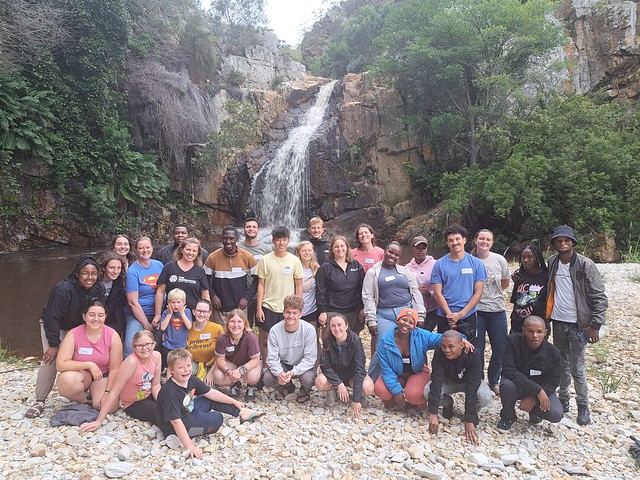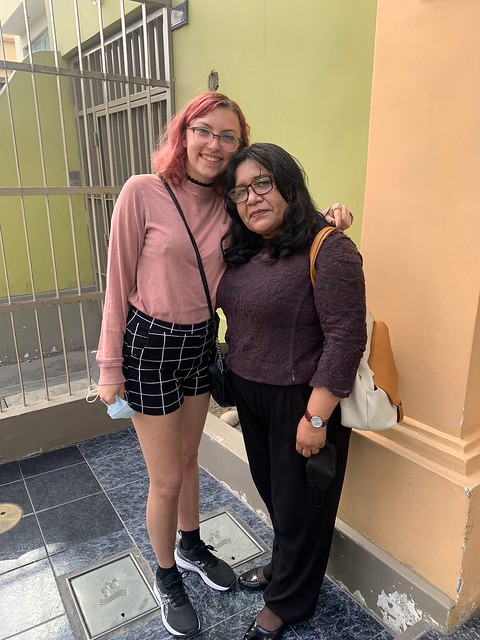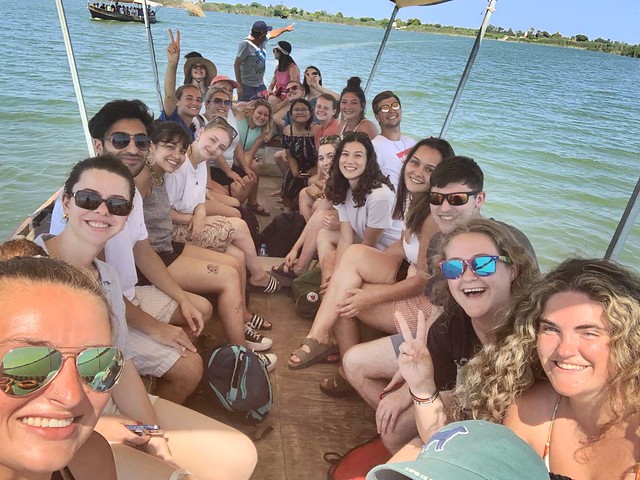On Friday night our group hosted Ariel, a previous student with the South Africa 2019 intercultural group. She was able to share some insight as well as tips for us, as we continued with our journey forward.
The next day was a bit more of a relaxed rest day. However, after dinner, we reconvened, and as a group attended an NBA game in Washington DC, to watch the Washington Wizards play the Orlando Magic. The Wizards were able to easily win, and it was a fun night spending time together as a group, as well as enjoying the hyped atmosphere of the arena.
On Sunday, our group attended church at St. Teresa of Avila Catholic Church. It was a very interesting experience for our group as a whole and differed vastly from our previous experience at the Baptist church. Here, we were invited to the very front of the church to reserved seats, as special guests of the church. It was a new experience for most of us, though a few had previous experiences at Catholic churches. Regardless, it was very enjoyable and interesting to be in an atmosphere of a new place and meet and talk to new friends. After church, we split up and explored Anacostia in different small groups in order to find lunch. Sunday night was spent hanging out around the apartments in a group as well as watching a football game. Finally, we all focused on making sure that everything was packed as we began to prepare for our long travel the next day.
—Caleb

After ten days in D.C., we finally set out on the long journey to South Africa on Monday morning. Since we had to be out of our hotel rooms at 11:00 am, we spent the morning packing up before hopping on the bus and metro to Dulles International Airport 10 hours before our flight was scheduled to leave. Those hours were spent playing with the hacky sack, reading, playing cards, or sleeping. Finally, we boarded our plane at about 11:30 pm. The first leg of our trek lasted about 10 hours and despite desperately trying to sleep, many of us got only between 1-5 hours of sleep. We landed in Istanbul, Turkey at around 4:30 pm local time on Tuesday and were shocked to see such a massive space with dozens of restaurants and stores. The final leg of our trek took off around 2:30 am local time and was again about 9 hours. FINALLY, we landed in Johannesburg around 11:00 am local time on Wednesday.
Thankfully, we made it through customs and got our Visas without any problems. The first step out into the fresh air of Jo’burg was incredible for many reasons including that it meant the long-awaited journey of our time in South Africa had begun but also because we hadn’t been outside in 40+ hours. We boarded the bus to where we will be staying during our time in Johannesburg which is St. Benedict’s House. Many of us mentioned as we drove that the only thing really reminding us that we weren’t in the United States was that we were driving on the opposite side of the road that we are used to.
A few people were able to stay up for a bit longer talking, but I was utterly exhausted and passed out around 8:30 pm local time.
-Anya Kauffman
 Our first full day in South Africa began with a delicious breakfast of Fat Cakes mincemeat accompanied by some oatmeal, fruit, and a variety of tropical juices. After breakfast, we meet in the chapel within St. Benedict’s with our group as well as two of our local leaders from Johannesburg, Mzi and Nkosi. We went around the circle introducing ourselves, explaining briefly why we wanted to come to South Africa, and what we expect from our time here. This hour was filled with lots of laughs and thoughtful reflections from our own group and our leaders. After a short bible study on Genesis 41-42, we got ready to leave. We left the “ranch” (as Andrew calls any place we stay for more than a couple of days) and went to a mall to pick up some snacks and toiletries we were missing. From the mall, we made the trek out of the city to Marupeng (which translates in English to Cradle of Humankind) which is the location where the first humanoid bones were discovered. When we arrived, we grabbed some lunch, and then went into the museum built on the premises. We started off our trip through the museum with a little Disney World-esque boat ride through some tunnels that showed representation of the 4 elements that sustain life on earth. After hopping out of our boats, we explored the different exhibits of the museum that showed the evolution of humans through the years. We spent close to an hour in the museum and then left out the back doors. To our surprise, there was a beautiful 180-degree view that we took in as we exited. (seen below). We sat in silence for a while taking in the view. Then we engaged in an impromptu hour-long discussion about theology and evolution, inspired by our learning in the museum. Afterward, we trekked back to the “ranch” and ate dinner together. Finally, several of us ended the day with some soccer in the courtyard. Our first full day in South Africa was a success.
Our first full day in South Africa began with a delicious breakfast of Fat Cakes mincemeat accompanied by some oatmeal, fruit, and a variety of tropical juices. After breakfast, we meet in the chapel within St. Benedict’s with our group as well as two of our local leaders from Johannesburg, Mzi and Nkosi. We went around the circle introducing ourselves, explaining briefly why we wanted to come to South Africa, and what we expect from our time here. This hour was filled with lots of laughs and thoughtful reflections from our own group and our leaders. After a short bible study on Genesis 41-42, we got ready to leave. We left the “ranch” (as Andrew calls any place we stay for more than a couple of days) and went to a mall to pick up some snacks and toiletries we were missing. From the mall, we made the trek out of the city to Marupeng (which translates in English to Cradle of Humankind) which is the location where the first humanoid bones were discovered. When we arrived, we grabbed some lunch, and then went into the museum built on the premises. We started off our trip through the museum with a little Disney World-esque boat ride through some tunnels that showed representation of the 4 elements that sustain life on earth. After hopping out of our boats, we explored the different exhibits of the museum that showed the evolution of humans through the years. We spent close to an hour in the museum and then left out the back doors. To our surprise, there was a beautiful 180-degree view that we took in as we exited. (seen below). We sat in silence for a while taking in the view. Then we engaged in an impromptu hour-long discussion about theology and evolution, inspired by our learning in the museum. Afterward, we trekked back to the “ranch” and ate dinner together. Finally, several of us ended the day with some soccer in the courtyard. Our first full day in South Africa was a success.
-Ben Alderfer
Friday, Jan 27
After another wonderful breakfast at St. Benedict’s and a brief tour of St. Peter’s School, the private school adjacent to St. Benedict’s monastery, we set out for downtown Jo’burg. Our first stop was the Apartheid Museum.
The museum begins nearly 3000 years in the past and tells the story of the many people who have lived on and fought over the land of South Africa and the riches it holds, with special emphasis beginning in the 1940s. In the last 80 years, South Africa has seen the rise of the Nationalist Party, the Afrikaner government which instituted apartheid; the rise and constant evolution of the opposition (anti-apartheid) movement; the downfall of apartheid; the hard work of establishing democracy which followed; and the creation and work of the Truth and Reconciliation Commission.
South Africans (especially blacks, but also coloureds, Indians, and any whites who dared to question the status quo) faced constant indignities, displacement, intentionally bad education, complete lack of economic opportunity, unimaginably violent murders, and horrific human rights violations. In spite of the rampant hatred, violence, mistrust, and fear, South Africa has shown a truly remarkable capacity for endurance, forgiveness, reconciliation, truth-telling, and peace.
Constitution Hill was next up on our agenda. We enjoyed a picnic lunch on the grounds of the former women’s prison before going on a guided tour of the men’s prison just down the hill. The three prisons (one for white men, one for non-white men, and one for women) were shut down in the 1980s due to human rights violations, including overcrowding, malnourishment, and rampant crime and disease. These prisons held everyone from political prisoners to hardened criminals.
We finished the day at Little Addis, an Ethiopian restaurant, where the owner and chef treated us to wonderful food, wonderful coffee, and wonderful stories of his childhood in Ethiopia.
-Emma Nord





























